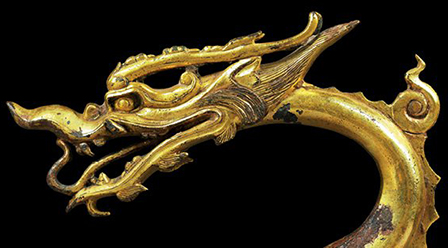 Currently on display at the Art Gallery of New South Wales, Tang: treasures from the Silk Road capital is the first exhibition in Australia to focus on the art of the Tang Empire.
Currently on display at the Art Gallery of New South Wales, Tang: treasures from the Silk Road capital is the first exhibition in Australia to focus on the art of the Tang Empire.
Tang: treasures from the Silk Road capital features a wondrous array of rare gold, silver and glass artefacts as well as ceramics, sculptures and mural paintings from the Tang Empire, many of which are national treasures of China and attesting to their great cultural significance, some of the 135 objects have never before been exhibited outside China.
Art Gallery of New South Wales director Dr Michael Brand said the Gallery is extremely privileged to host such an extensive range of precious Chinese treasures.
“For the first time, Australian audiences are able to appreciate the high artistic achievements and rich history of this golden age of China,” Dr Brand said. “Tang is the third exhibition from the Shaanxi Province to be held at the Gallery following the very successful Qinshihuang’s terracotta warriors and horses in 1983 and The First Emperor: China’s entombed warriors in 2010-11.”
“There are many people to thank for making this exhibition possible, but in particular I wish to thank Cheng Jianzheng, former director of the Shaanxi History Museum, whose meeting with me in Sydney in 2012 was not only the inspiration for this exceptional project, but the first meeting I had with an international museum director after I started at the Gallery.”
While Europe was still in the Dark Ages the Tang Empire (618-907) became the richest and most powerful realm in the world. At the heart of the Tang Empire was its capital city, Chang’an (present day Xi’an). Home to one million people and situated at the start of the famous Silk Road trade route, this cosmopolitan metropolis was renowned as a city of great wealth, cultural diversity and religious devotion.
Tang: treasures from the Silk Road capital focuses on life in Chang’an during the Tang Empire. Each of the artifacts in the exhibition carries a story from this extraordinary city: from the elevation of tea drinking to an art form; the booming artisanship in gold, silver and ceramics; to great innovations in Chinese fashion and music.
“The works on display in Tang: treasures from the Silk Road capital demonstrate exceptional craftsmanship and storytelling power including a 9th century tea grinder that belonged to Emperor Xizong; an early 8th century mural from the walls inside Prince Jiemin’s tomb; and a Hayagr?va statue from the site of the Anguo Monastery, one of the important Buddhist centres of the late Tang dynasty,” said Yin Cao, curator of Chinese art at the Art Gallery of NSW.
The exhibition brings to light the fascinating lifestyle of the women of Chang’an. The diverse culture of Chang’an during the Tang dynasty brought about a time of great tolerance and openness that saw women gain a remarkable increase in freedom. The apex of this empowerment was the more than 20-year reign of Empress Wu Zeitan, the only female sovereign in Chinese dynastic history. Women were also increasingly represented in art during the Tang dynasty.
Buddhism thrived in the Tang Empire with many emperors offering imperial patronage of the religion. Private patrons were also prevalent with merchants, foreign dignitaries, women’s groups, military leaders and families sponsoring impressive temples such as the Mogao Grottoes.
An art treasury comprising over 700 caves, the Mogao Grottoes abound with murals, statues and architectural monuments. They are located near the oasis town of Dunhaung in northwestern China, which during the Tang Dynasty was a major crossroads on the Silk Road.
Tang: treasures from the Silk Road capital is accompanied by Pure Land: inside the Mogao Grottoes at Dunhuang – a spectacular interactive installation of one of the UNESCO World Heritage listed Mogao Grottoes, known as the ‘Caves of the Thousand Buddhas’ – now closed to public for conservation reasons.
Dr Brand said the Gallery at every opportunity is looking to incorporate appropriate technologies into exhibitions to enhance the experience of visitors viewing art. “Using pioneering 3D augmented-reality technology, Pure Land: inside the Mogao Grottoes at Dunhuang is a near life-sized reconstruction that transports visitors using iPads to view the intricate wall paintings and statues of this ancient hidden treasure,” Dr Brand said.
Pure Land: inside the Mogao Grottoes at Dunhuang was developed in collaboration with Professor Sarah Kenderdine (University of NSW), City University of Hong Kong and the Dunhuang Academy, China.
Tang: treasures from the Silk Road capital
Art Gallery of New South Wales, Art Gallery Road, The Domain (Sydney)
Exhibition continues to 10 July 2016
Admission fees apply
For more information, visit: www.artgallery.nsw.gov.au for details.
Image: Dragon c700s (detail), gilded bronze with an iron core unearthed from Caochangpo in the southern suburb of Xi’an, 1975. Shaanxi History Museum
